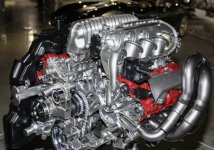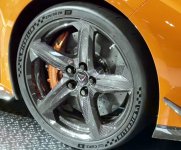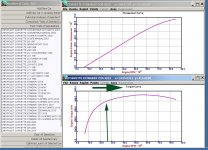teamzr1
Supporting vendor
The world’s most powerful naturally aspirated V8 benefits from a 19th-century principal and clever 21st-century engineering by GM.
The benefit of optimizing induction resonance is that pressure within the plenums rises to help overfill the cylinders with air.”
The 2023 Corvette Z06 recently arrived, powered by a 5.5-L LT6 V8 (below) spinning a radical flat-plane crankshaft.
Now that additional engineering details have emerged, the LT6’s top hat has supplanted its crankshaft as this engine’s most interesting feature.
That topper an active induction system is capable of filling this DOHC V8 with the air needed to produce SAE-certified 670 hp (499 kW; 121.8 hp/L) at 8400 rpm without help from an external boosting device.
Let the record show that the LT6 is the most powerful naturally aspirated V8 ever produced.
The 6.6-L 622-hp (94.2 hp/L) M159 engine energizing the Mercedes-Benz SLS AMG Black Series coupe has been bumped down to second place.
While exemplary output qualifies the Z06 as a legitimate supercar, bountiful torque is what owners will most appreciate on the street.
To maximize twist, GM engineers tapped a phenomenon discovered in the 19th century by German physicist Hermann von Helmholtz: that air vibrating inside a closed chamber at a pressure slightly above atmospheric produces the sounds emanating from guitars and whistles.
What we now call Helmholtz resonance is the technology underlying the positive intake manifold pressures that inflate the LT6’s torque curve over a broad rpm range.
Standing tall between this V8’s red-painted cam covers, the LT6’s induction system consists of two molded-nylon chambers.
Two 87-mm throttle bodies admit air to these manifolds, each of which has an internal volume of 5.5 liters.
The extensively ribbed, mirror-image plenums are joined along their lengths by three ‘communicator’ valves.
While the driver’s right foot operates the throttles (by wire), the servo-operated communicator valves are commanded by the LT6’s electronic control module.
Two of the communicators open and close in tandem, while the third operates on a separate schedule. Inside each plenum, there are four molded-plastic trumpets feeding the cylinders with utmost efficiency.
Downstream, each intake runner splits in two to feed a pair of titanium intake valves per cylinder.
The mass of the air stream causes pressure waves to reverberate throughout the induction system every time an intake valve closes at the beginning of the compression stroke.
At wide open throttle, the communicators remain closed until 2000 rpm, when the paired set opens to foster resonance between the two plenums.
As rpm and air flow surge, the third valve snaps open at 5800 rpm.
The benefit of optimizing induction resonance is that pressure within the plenums rises to help overfill the cylinders with air.
Instead of the usual arched torque curve, LT6 output is a nearly flat line comprised of three short-duration humps blended by the active induction system.
The apogee is a muscular SAE-certified 460 lb-ft at 6300 rpm. Volumetric efficiency, the measure of how well air and exhaust flow through an engine, tops 110%.
In addition to the above WOT strategy for Sport driving, the LT6’s control module offers five additional collaborator-opening programs for the Z06’s Tour, Stealth, and Track driving modes.

The benefit of optimizing induction resonance is that pressure within the plenums rises to help overfill the cylinders with air.”
The 2023 Corvette Z06 recently arrived, powered by a 5.5-L LT6 V8 (below) spinning a radical flat-plane crankshaft.
Now that additional engineering details have emerged, the LT6’s top hat has supplanted its crankshaft as this engine’s most interesting feature.
That topper an active induction system is capable of filling this DOHC V8 with the air needed to produce SAE-certified 670 hp (499 kW; 121.8 hp/L) at 8400 rpm without help from an external boosting device.
Let the record show that the LT6 is the most powerful naturally aspirated V8 ever produced.
The 6.6-L 622-hp (94.2 hp/L) M159 engine energizing the Mercedes-Benz SLS AMG Black Series coupe has been bumped down to second place.
While exemplary output qualifies the Z06 as a legitimate supercar, bountiful torque is what owners will most appreciate on the street.
To maximize twist, GM engineers tapped a phenomenon discovered in the 19th century by German physicist Hermann von Helmholtz: that air vibrating inside a closed chamber at a pressure slightly above atmospheric produces the sounds emanating from guitars and whistles.
What we now call Helmholtz resonance is the technology underlying the positive intake manifold pressures that inflate the LT6’s torque curve over a broad rpm range.
Standing tall between this V8’s red-painted cam covers, the LT6’s induction system consists of two molded-nylon chambers.
Two 87-mm throttle bodies admit air to these manifolds, each of which has an internal volume of 5.5 liters.
The extensively ribbed, mirror-image plenums are joined along their lengths by three ‘communicator’ valves.
While the driver’s right foot operates the throttles (by wire), the servo-operated communicator valves are commanded by the LT6’s electronic control module.
Two of the communicators open and close in tandem, while the third operates on a separate schedule. Inside each plenum, there are four molded-plastic trumpets feeding the cylinders with utmost efficiency.
Downstream, each intake runner splits in two to feed a pair of titanium intake valves per cylinder.
The mass of the air stream causes pressure waves to reverberate throughout the induction system every time an intake valve closes at the beginning of the compression stroke.
At wide open throttle, the communicators remain closed until 2000 rpm, when the paired set opens to foster resonance between the two plenums.
As rpm and air flow surge, the third valve snaps open at 5800 rpm.
The benefit of optimizing induction resonance is that pressure within the plenums rises to help overfill the cylinders with air.
Instead of the usual arched torque curve, LT6 output is a nearly flat line comprised of three short-duration humps blended by the active induction system.
The apogee is a muscular SAE-certified 460 lb-ft at 6300 rpm. Volumetric efficiency, the measure of how well air and exhaust flow through an engine, tops 110%.
In addition to the above WOT strategy for Sport driving, the LT6’s control module offers five additional collaborator-opening programs for the Z06’s Tour, Stealth, and Track driving modes.





